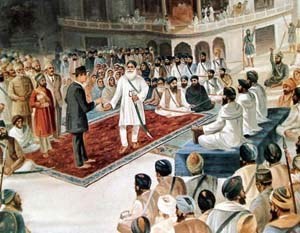BISHAN SINGH, SANT (d. 1973), holy saint most of whose life was spent in works of seva, raising of buildings by labour volunteered by devotees, at different shrine sites, came of a well to do Sindhi family. Nothing is known about his early life except that his parents were Sahajdhari Sikhs and that he was in government service when he came in 1940 to the Punjab on a pilgrimage visiting Sikh places of worship and saw Sant Gurmukh Singh of Patiala, then engaged in massive works of seva reconstructing the shrines and sacred pools at Khadur Sahib and Goindval. Bishan Singh was so impressed by the piousness, humility and devotion of Sant Gurmukh Singh and of the large number of Sikhs volunteering their labour that he resigned his post in the government, gave away his personal belongings and joined the holy company.
CHET SINGH, military commander, engineer and a kardar, i.e. a revenue officer, under Maharaja Ranjit Singh. In 1831 he became engineer in charge for constructing a bridge over the River Sutlej for the Ropar meeting between Maharaja Ranjit Singh and Governor General William Bentinck. He constructed another bridge at Harike in 1837 to enable the British commanderin chief to cross over the Sutlej for his visit to Lahore. Earlier in 1833 he was appointed kardar of the cisSutlej estates of the Maharaja. In 1835, he was deputed to Anandpur to settle the dispute between the local Sodhi factions.
DEVINDER SINGH, RAJA (1822-1865), was born on 5 September 1822, the son of Raja Jasvant Singh of Nabha. He ascended the throne of Nabha on 5 October 1840 at the age of eighteen. During the first AngloSikh war of 184546, Devinder Singh whose sympathy was with the Lahore Darbar did not help the British for which reason nearly a quarter of his possessions were confiscated and he was removed from his state and sent to Mathura. He was granted an annual pension of Rs 50,000, and in his place his minor son, Bharpur Singh, was installed on the gaddi. In December 1855, Raja Devinder Singh was shifted to Maharaja Kharak Singh`s mansion in Lahore where he died ten years later, in November 1865.
DHARA SINGH (d. 1860) succeeded his father, Mehar Singh, to the family estate situated in the Nakka tract of land upon the latter`s death in 1843. Dhara Singh joined Raja Sher Singh with his horsemen at Multan in 1848. He fought against the British in the battles of Ramnagar (22 November 1848) and Gujrat (21 February 1849). He died in 1860.
DINA NATH, PANDIT (b. 1888), active supporter of and participant in the Sikh Gurdwara reform movement 1920-25, was born in 1888, the son of Pandit Bal Krishan of Amritsar. In the wake of the agrarian protest in the Punjab in 1907, he joined the Indian National Congress. He was secretary of the Amritsar District Congress Committee when the Gurdwara reform or AkaIi movement got under way with the establishment in November 1920 of a representative Sikh body, the Shiromani Gurdwara Parbandhak Committee. Pandit Dina Nath was in sympathy with the movement and joined the Akali agitation for the restoration of the keys of the to shakhana or treasury of the Darbar Sahib, which had been taken away by the British Deputy Commissioner on 7 November 1921.
- 1
- 2




